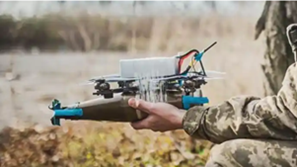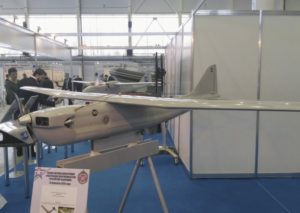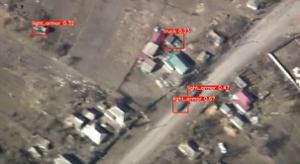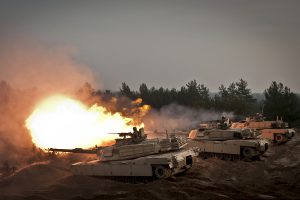“I don’t think America, or the West in general, is prepared in any sort of way to fight a static war like we’re seeing over there in Ukraine.”
[Editor’s Note: One of the twelve key conditions driving the Operational Environment (OE) in the next ten years is its increased lethality. According to the TRADOC G-2‘s recently published The Operational Environment 2024-2034: Large-Scale Combat Operations:
“LSCO will be increasingly lethal due to the intersection of sensor ubiquity, battlefield automation, precision strike, and massed fires.“
We’ve seen an increase in the production, employment, and success of Unmanned Aerial Systems (UAS) on the battlefield in recent years. These systems were integral components of the Azeri victory in the Second Nagorno-Karabakh War – specifically the Turkish Bayraktar TB2 and Israeli Harop – and are proving vital in the on-going Russo-Ukrainian war. Indeed, during this latter conflict, the ever evolving UAS/Counter-UAS (C-UAS) fight has led to rapid adaptations on both sides as they seek to achieve battlefield advantage. Yet any advantage achieved is fleeting — as observed by Daniel Patt, a senior fellow at the Hudson Institute, “The peak efficiency of a new weapon system is only about two weeks before countermeasures emerge.”
In our latest episode of Army Mad Scientist’s The Convergence podcast, we sat down with Wolfgang Hagarty to learn first-hand about the on-going war in Ukraine, its rapidly evolving UAS/C-UAS fight, and the overarching impacts of technological innovation on the changing character of warfare — Enjoy!]
[If the podcast dashboard above is not rendering correctly for you, please click here to listen to the podcast.]
 Wolfgang Hagarty — a United States Marine Corps veteran — joined the Ukrainian Armed Forces (UAF) in 2022 as an intelligence officer. He took part in the UAF’s Kharkiv offensive as well as the Kherson offensive. He became a team leader and focused primarily on the UAS/C-UAS fight as well as Electronic Warfare (EW) and counter-EW.
Wolfgang Hagarty — a United States Marine Corps veteran — joined the Ukrainian Armed Forces (UAF) in 2022 as an intelligence officer. He took part in the UAF’s Kharkiv offensive as well as the Kherson offensive. He became a team leader and focused primarily on the UAS/C-UAS fight as well as Electronic Warfare (EW) and counter-EW.
Army Mad Scientist sat down with Mr. Hagarty to talk about his experiences fighting in Ukraine, his opinions on the rise of UAS, and his thoughts on the evolution of Large-Scale Combat Operations (LSCO). The following bullet points highlight key takeaways from our conversation:
-
-
-

UAF FPV Drone with the 53rd (Volodymyr Monomakh) Separate Mechanized Brigade / Source: Facebook page for the General Staff of the Armed Forces of Ukraine, via Ukrainska Pravda First-Person View (FPV) drones have become a very cost-effective way for Ukraine to achieve precision strikes. Their ubiquity on the battlefield initially arose from Ukraine’s shortage of artillery shells. The UAF soon realized dismounted infantry teams could find and finish Russian targets with precision strikes using fewer drones than conventional artillery firing masses of ordnance.
-
-
-
-
-

Russian Orlan-30 Reconnaissance UAS / Source: TRADOC G-2‘s OE Data Integration Network (ODIN) Worldwide Equipment Guide (WEG) To counter Russian reconnaissance UAS, like the larger Orlan-10 and -30, the Ukrainians would identify the systems through direction finding means and pass that information on to mobile anti-aircraft units to shoot them down. Russian FPV UAS presented the UAF with a much more difficult C-UAS conundrum. These smaller UAS have shorter ranges and flight times, so an individual UAF soldier or unit would have to already be in the vicinity of where the Russian FPV UAS were operating to effectively target and neutralize them using a man-portable EW C-UAS jamming gun.
-
-
-
-
- The vast majority of the materiel Mr. Hagarty and his teams relied on employed open-source software and hardware. Occasionally, they would receive commercial products to test and employ, but the effectiveness of those systems was too inconsistent to be useful. For example, the only effective EW C-UAS jamming gun he employed was manufactured in Ukraine. Mr. Hagarty found that all EW C-UAS jamming guns manufactured in the West (that he used) were ineffective. Further, he recounted that no western-manufactured drones (that he used) lasted more than one mission — instead, his units relied on either Mavic drones produced by China’s DJI or custom-built (i.e., domestically-produced Ukrainian) systems.
-
-
-
-

Video still captured from a Ukrainian Armed Force’s Saker Heavy Bomber UAS — its Full Automatic Machine Vision (i.e., Artificial Intelligence) spots, locates, identifies, and selects targets automatically / Source: Still captured from X (tweet) posted by Ukrainian Front (@front_ukrainian) The UAF have established a live-streaming system so that all relevant units can see live feeds from systems currently in the air. This common operating picture reduces overlap, allows operators to identify targets, and enables shooters to correct missed shots in real time without being told or waiting for observers to relay new targeting information. Now everyone in the UAF — not just special forces units — have “eyes in the sky.”
-
-
-
-
 The future fight will allow for maneuver warfare or static warfare. Maneuver warfare requires air superiority or artillery superiority. In Ukraine, it’s largely been a static war of attrition. With adversaries able to produce effects in all domains, the U.S. may not have air superiority in the next fight. Mr. Hagarty also doesn’t believe the U.S. is prepared for a static fight, nor does he think the U.S. and its citizens are prepared for the combat losses associated with a protracted static fight.
The future fight will allow for maneuver warfare or static warfare. Maneuver warfare requires air superiority or artillery superiority. In Ukraine, it’s largely been a static war of attrition. With adversaries able to produce effects in all domains, the U.S. may not have air superiority in the next fight. Mr. Hagarty also doesn’t believe the U.S. is prepared for a static fight, nor does he think the U.S. and its citizens are prepared for the combat losses associated with a protracted static fight.
-

Stay tuned to the Mad Scientist Laboratory for our next episode of The Convergence on 19 September 2024, when we sit down with Andrew Olson to discuss how wargaming can provide our Leaders with the requisite situational understanding of how they can successfully execute combat operations, achieve mission objectives, and win decisively on the battlefield, while simultaneously complying with our Nation’s Civilian Harm Mitigation and Response (CHMR) policy.
If you enjoyed this post, check out the TRADOC G-2’s new OE Assessment — The Operational Environment 2024-2034: Large-Scale Combat Operations
Explore the TRADOC G-2‘s Operational Environment Enterprise web page, brimming with information on the OE and how our adversaries fight, including:
Our China Landing Zone, full of information regarding our pacing challenge, including ATP 7-100.3, Chinese Tactics, BiteSize China weekly topics, People’s Liberation Army Ground Forces Quick Reference Guide, and our thirty-plus snapshots captured to date addressing what China is learning about the Operational Environment from Russia’s war against Ukraine (note that a DoD Common Access Card [CAC] is required to access this last link).
Our Russia Landing Zone, including the BiteSize Russia weekly topics. If you have a CAC, you’ll be especially interested in reviewing our weekly RUS-UKR Conflict Running Estimates and associated Narratives, capturing what we learned about the contemporary Russian way of war in Ukraine over the past two years and the ramifications for U.S. Army modernization across DOTMLPF-P.
Our Running Estimates SharePoint site (also requires a CAC to access), containing our monthly OE Running Estimates, associated Narratives, and the 2QFY24 and 3QFY24 OE Assessment TRADOC Intelligence Posts (TIPs).
Check out the following related Mad Scientist Laboratory content:
Unmanned Capabilities in Today’s Battlespace
Revolutionizing 21st Century Warfighting: UAVs and C-UAS
Death From Above! The Evolution of sUAS Technology and associated podcast, with COL Bill Edwards (USA-Ret.)
Jomini’s Revenge: Mass Strikes Back! by proclaimed Mad Scientist Zachery Tyson Brown
Insights from the Robotics and Autonomy Series of Virtual Events, as well as all of the associated webinar content (presenter biographies, slide decks, and notes) and associated videos
Insights from Ukraine on the Operational Environment and the Changing Character of Warfare
Through Soldiers’ Eyes: The Future of Ground Combat and its associated podcast
The PLA and UAVs – Automating the Battlefield and Enhancing Training
A Chinese Perspective on Future Urban Unmanned Operations
China: “New Concepts” in Unmanned Combat and Cyber and Electronic Warfare
The PLA: Close Combat in the Information Age and the “Blade of Victory”
“Once More unto The Breach Dear Friends”: From English Longbows to Azerbaijani Drones, Army Modernization STILL Means More than Materiel, by Ian Sullivan.
The Operational Environment’s Increased Lethality
Turkey and the TB-2: A Rising Drone Superpower and its associated podcast, with Karen Kaya
Disclaimer: The views expressed in this blog post do not necessarily reflect those of the U.S. Department of Defense, Department of the Army, Army Futures Command (AFC), or Training and Doctrine Command (TRADOC).




Thanks Wolfgang Hagarty !